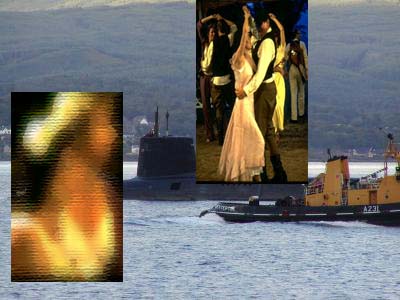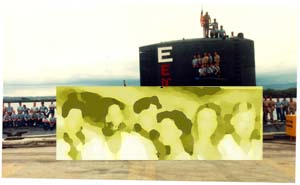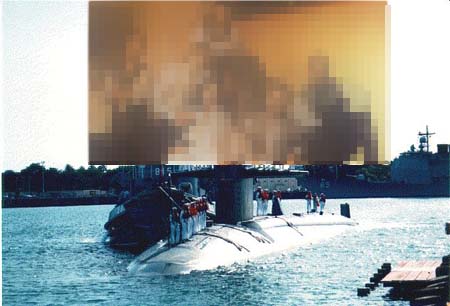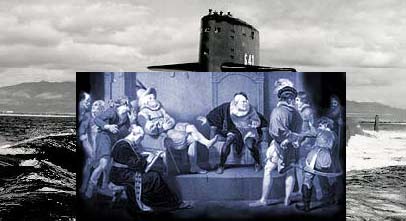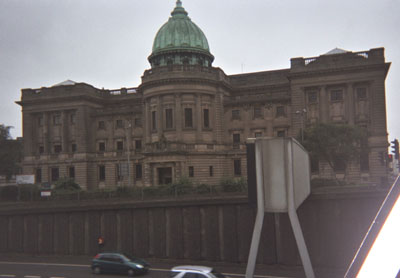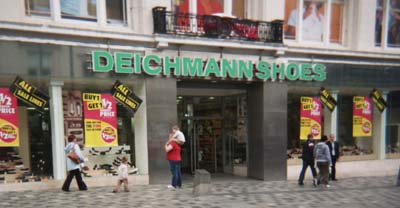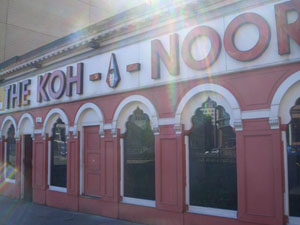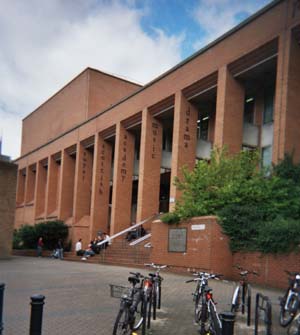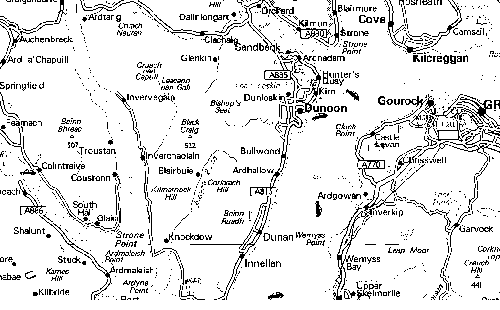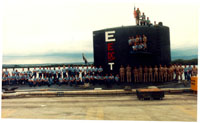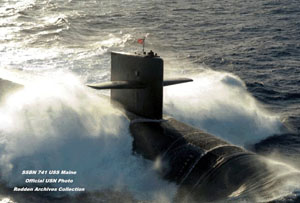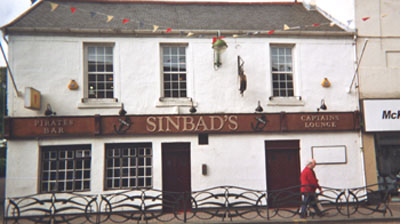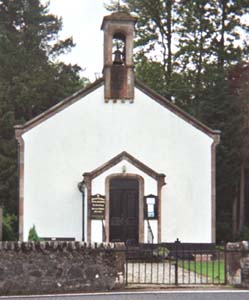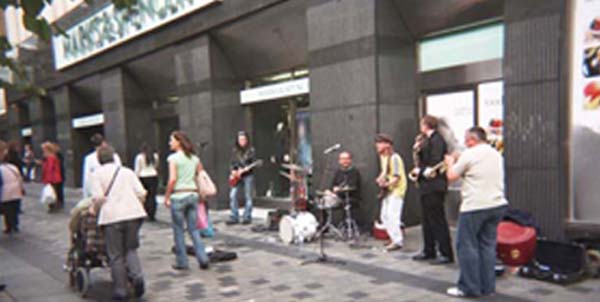Travelogue:Scotland
Glasgow
Saturday, August 26,2006
The intersection of North Street with Sauchiehall ( pronounced "Saek'y-awl") is a hell of a situation for a public library. Two centuries ago this neighborhood was no doubt the epitome of elegance. With the implantation of the Charing Cross Train Station it became the focus for multiple highways, underpasses, overpasses ,cloverleafs and oversized office buildings. The addition of the train turns this district into a blighted monument to post-industrial civilization.
The Mitchell Centre seen from across North Street
The Mitchell Centre , which houses the Mitchell Library, is actually a complex of buildings held together by long corridors and a containing shell. Seen from the front one gets the impression of a state capitol that hasn't been cleaned since the Georgian age.
Major renovations are underway ; in local parlance, it's being "developed". I waited from 8:30 AM on the balustrade of a small terrace before the front doors. When they were opened at 9 I entered into a gloomy , and a walk-up of 3 or 4 steps of black marble, to get to a dim corridor leading off at the perpendicular in both directions. At the head of the stairs stands a reception desk. Two very bored receptionists, whose only function seems to be to give directions, were seated behind it. They also sell postcards and may occasionally point out the informative pamphlets stacked on an adjacent shelf.
Proceeding to the right and through a pair of massive doors one reaches the Mitchell Cafe after a short distance. I returned there after lunch and will say a few words about it later.
The long trajectory to the Mitchell Library takes off from the reception desk to the left. I walked about 30 meters through a solemn though not forbidding corridor to execute a right hand jog at the far end, coincidentally at the corner where a security guard sits immobilized. Another swinging door vanquished, and I entered a space adorned with an exhibition of photographs and drawings based on Chinese subjects. Turning left again brought me into a confined space flanked by wooden and cardboard sidings, draped with plastic tarpaulins, with faded and threadbare old carpets on the cold brick floors, noises of drills, saws, hammers, curses, bags of cement, water dripping onto the ground or in stagnant pools. A garish and unsteady illumination seemed as if it might decide to give out at any moment. My persistent advance through this hallucination paid off, and I arrived at a bank of 3 elevators against the right wall, and a low-pitched richly carpeted helical staircase to the left, twin means of access to the library's entrance on the 3rd floor.
Most of Saturday morning was spent in the library's computer center, writing up and sending out the first installment of this report. On the way out I visited the 2nd floor where there are postcards for sale holding drawings of Glasgow local color and human interest. I bought 5 of these. One was sent right away to the Duchesse, (whom I'd reason to believe was on her way to Toronto) . Its front displayed a street scene from the 19th century. The space normally available for writing on the reverse side was almost entirely covered by a stamped message, chiding the sender lest she/he forget to include the postal code with the address!
Examples of this sort of micromanagement are ubiquitous in the UK : one sees signs cautioning one to lock bathroom doors if one wants privacy, notes on spigots warning that the water may be "very hot", admonitions against littering ( including the warning of a £10,000 fine for throwing things into the Clyde! ) , poop-scoop reminders for dog walkers, and things of a similar nature. Notices of this sort, which appear quaint and faintly comforting at the beginning, soon take on a disturbing quality, as if the State, universally referred to as the Big Brother, may have taken on the role of the Big Mother as well.
At around 11 I proceeded down Sauchiehall Street to the Mall, where I picked up a new pair of shoes at Dechmann's ( £ 13 and worth the money ) .
Dechmann's Shoe Store
I then returned to the neighborhood of the Mitchell Center again, to avail myself of the £6 luncheon special at the Koh-i-noor Restaurant at 210 North Street.
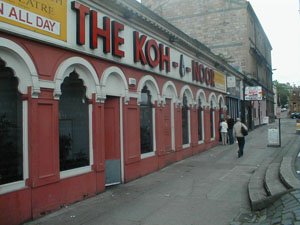
The Kohinoor Restaurant
Many restaurateurs believe that atmosphere, the more and heavier the better, is essential to the success of their enterprise. This anxiety tends to increase as a function of the allegedly exotic origins of the cuisine and the weirdness of the standard digestibles of its culinary traditions . I don't think that the customers at the Koh-i-noor believe that the Punjab, or Punjabi cuisine, are as bizarre as the management of the Koh-i-noor imagines they do. The lengths to which the proprietors have gone to create an interior vaguely reminiscent of someone's idea of the court of Akbar have only succeeded, in my mind, in creating the hovering presence of a faded Hollywood set for an old movie. With a little more work they might have come up with something that would really allow one to forget the environmental disaster of the vast motorized caverns on North Street.
I entered the door wearing my backpack and holding in my right hand a plastic bag containing my new shoes in a box. The first person I encountered as was a somewhat harried man, one of the two waiters on duty that afternoon. He was of medium height, dressed in a certain kind of standard waiter livery, and with an air of intimidation about him. I initially believed I'd caused it but later realized that it was his normal manner. His English was poor, and when I phrased a question in the single word "Buffet?", he looked at me with perplexity and despair.
"Yes, yes", he replied, repeating this mantra several times as he led me to a table along the south wall facing the inner court. Then he went to get the other waiter. From their heated exchange I gathered that he was telling his supervisor that he didn't know what this foreign lunatic wanted.
The other waiter, tall, nervous, and not at all intimidated, hurried over to me:
"What do you want?"
" Don't you advertise a £6 buffet?"
" We don't serve buffet here."
"Well, your lunch special then."
"Okay! Please be seated. What will you have to drink?"
In recent years almost every Indian restaurant I've been to offers an afternoon special buffet, but its possible that the practice hasn't yet migrated to Scotland. I was happy to see that my embarrassment at carrying a backpack into a restaurant was groundless. 4 backpacks belonging to the men at the table to my right , were piled up in a corner beside the entrance. It was time to relax.
A red hue infusing to all elements of the decor dominates the darkened interior of the Koh-i-noor : red tablecloths, red wallpapers, red carpets, red velvet curtains. As one can see from the above photograph, the blushing red of the exterior of the Koh-i-noor makes it easy to identify against an urbanscape pervasice in greys and muddy browns.
The tables of the inner room of the Koh-i-noor are laid out around a square central court. Between the ground level and two raised tiers stand arched pavilions supported by dusky red columns. These aren't on the backs of elephants (that would be too much!). yet the scalloped shapes of these arches bring to mind a number of images associated with India, such as:
- The flames of worldly passion
- The domes of the Taj Mahal, or
- The hoods of aroused cobras
At the center of this court sits a fountain surrounded by an octagonal shield of translucent plastic . The shield prevents one from seeing the fountain but there is a persistent sort of liquid gurgle indicating its existence. On the far walls stand vertical murals, conventional depictions of Lakshmi and Krishna. To the right is a tall mural of a somewhat bored lady strumming a Tamboura; it's a boring job.
The time was shortly after noon and there weren't many customers. The people at the table to my right, 4 burly and notably demonstrative gay men, were not in a mood to initiate conversations with me or anyone else. At a table a somewhat greater distance away to my left sat a man and woman ( married, etc...? ) The man was massively built, like a prize-fighter or night club bouncer. The woman appeared to have no unusual physical traits although it was difficult for me to see either of them clearly in the darkness. Both were Europeans; from their accents one could conclude that they were Scottish. The tall waiter returned. After depositing my entree in front of me he walked over to them. Soon all 3 were chatting merrily away in Punjabi. Empires make strange bedfellows.
If the atmosphere was more than a little obvious and contrived, the food was not. Everything was tasty, tasteful and well prepared: vegetable pakoris followed by lamb curry on a bed of saffron rice, with ice-cream for dessert. For the sake of this travelogue I should perhaps have spent a few more guineas and got myself a full-course dinner. As it happens I don't work with the budget of a Rick Steve - thereby allowing me up to expand on subjects besides food and shelter!
Leaving the Koh-in-noor I walked less than a block back to the Mitchell Center to sample the coffee in its cafe. An ordinary cup of coffee was $3.00, yet no better than standard fare in any of the coffee houses in Middletown, where one can get a very good cup of world trade coffees for as little as $1.60. There were only 3 customers in the room besides myself . Two waiters sat behind the counter, one a young man, the other a woman of about my age ( 68 as of this last September 24th !) . When I told her that a cup of coffee costs twice here what it does in the US, she uttered a surprised, throaty yet not unsympathetic "Well! " , as if that ended the matter.
The room's stuffy layout is not conducive to lingering over an afternoon break. It holds about a dozen low square wooden tables, accompanied with pairs of circular chairs , resembling blueprint diagrams of cylindrical sections and upholstered with some sort of black synthetic stuff.
At 2 o' clock I returned to the Youth Hostel. Park Terrace wraps around like the petals of an artichoke and I lost my way. Apart from the distress caused my habit of carrying too much luggage on my back, this diversion was not unpleasant. In fact I sometimes make it a point to get lost in unfamiliar cities (even in "bad" neighborhoods!) to embark upon a spontaneous voyage of discovery . That I'm still alive is a miracle, but of course this same observation applies to everyone on the planet.
With a few helpful redirections I soon made my way back to the hostel. I reserved two nights at the Loch Lomond hostel and at the Glasgow hostel again on September 7th prior to taking the plane home the next morning. Then I returned to the downtown to continue my exploration.
Climbing the steep streets in the vicinity of the Sauchiehall Mall brings one to Renfrew Street and a number of major cultural institutions: the Royal Scottish Academy of Music and Drama (RSAMD) , the Theatre Royal of Scotland (across the street and up another block) , and the Glasgow School of Art which we will visit in the next episode.
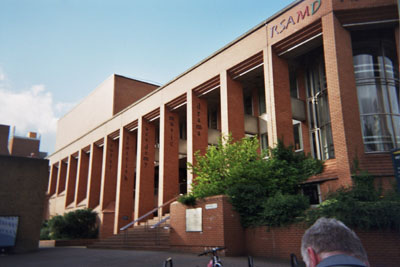
The Royal Scotland Academy of Music and Drama
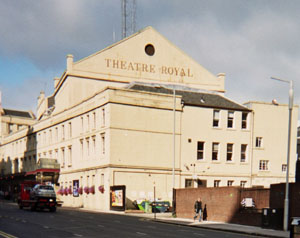
The Royal Theatre of Scotland
There seemed to be little of interest going on at the Theatre Royal, certainly not at the prices it was charging, so I returned back down the hill to visit and take pictures of the RSAMD. The RSAMD is a coalition of several performing arts schools. Entering from the ground level, one comes to a kind of road sign indicating the directions one needs to go to find each of these schools.
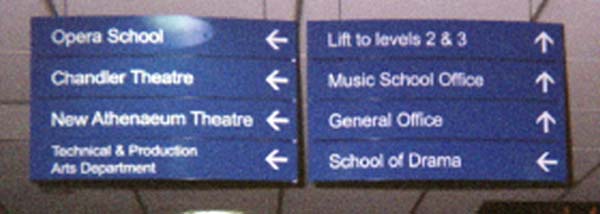
Sign in the basement of the RSAMD
( When this picture was taken the flashing of my camera set off an excited search by the security guard. He hurried around the corridors for awhile looking for the source of the disturbance before giving up. I decided that ignorance was bliss. )
On the way out I examined the bulletin boards to learn about the host of exciting plays and concerts I wouldn't be able to go to when I left for the Cowal Peninsula that Monday. Given that I'd made it very clear to myself that I wanted to spend most of my time "in nature" and only a little bit "in culture" on this trip, I had nothing to complain about; but I complained anyway, the human animal always demanding to have everything of everything at all times.
Some history: The RSAMD, the Theatre Royal
and the McDougle clan of thespians
In 1977 the McDougle family, Leif, Delphia, Lucinda and Saffron, rehearsed an adaptation of Much Ado About Nothing at the RSAMD and produced it for a run of 3 months at the Theatre Royal of Scotland. The production was in modern dress in a local setting, with every family member cast in some role.
In their adaptation, renamed Much Ado About Extinction , the locale is moved from Messina, Italy, ( which Shakespeare never visited anyway), to Faslane and Couport on the shores of the Holy Loch in Scotland, (which the Bard may have visited while researching background and local color for Macbeth . ) . Faslane , just across the lake from Kilmun and the backwoods log cabin of the McDougle family, was for 30 years the site of an American naval base .
Map of the Firth of Cyle, showing the Holy Loch and Kilmun

The Holy Loch
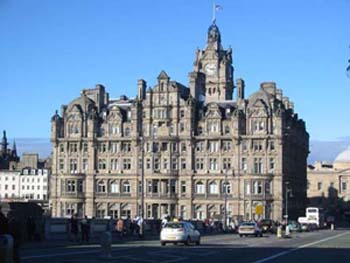
Faslane, as advertised to tourists
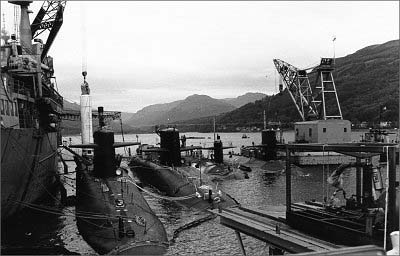

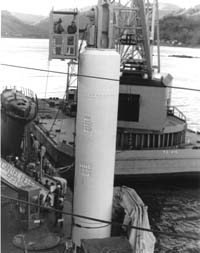
Faslane, as seen by tourists
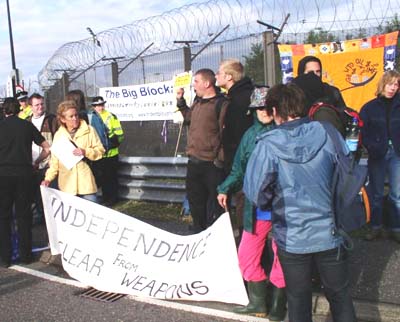
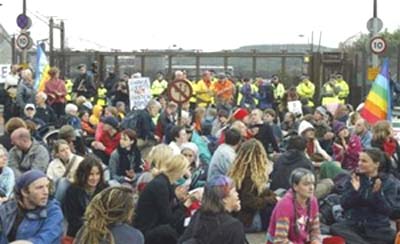
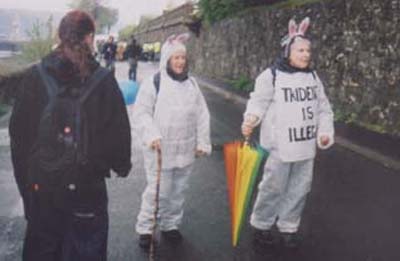
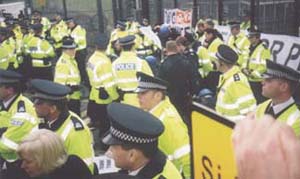
Faslane tourists
A British base during WWII, it was taken over by the Americans in 1959. The first nuclear submarines arrived in March of 1961 . Along with another base in neighboring Coulport it harbored Polaris nuclear submarines for 30 years, until 1992, when the Yanks, indifferent to the need to maintain full regional employment in a time of recession, pulled out the barbed wire and returned home. As reported in the Dunoon Observer on February 29, 1992 : " Thirty-one years of dollar subsidy ended for Dunoon last week. And with it, hopefully, the cultural and social deprivation which has to all intents and purposes inhibited growth and development of the area."
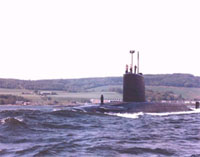
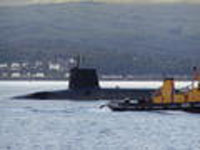
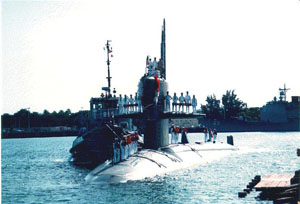
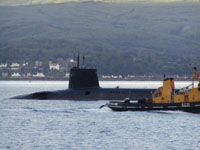

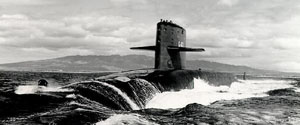
US Nuclear Submarines,
in the Holy Loch at one time or another
It is more than a little ironic that the McDougle clan should have sought to a "back-to-nature" refuge in the same area and at the same time that the US Navy was seeding it with dozens of nuclear submarines.
This tiny indentation of the Clyde Firth, no more than 3 square miles, is called the " Holy Loch" through its association with St. Munn, an Irish monk contemporary with the more famous St. Columba. Because the penetrating darshan of the noble 6th century monk has been supplanted , in our times, by the radiation emanating from the slag heaps of nuclear garbage, the lake continues to bask in a golden glow.
For the 30 years in which the bases were operative, the region was home to thousands of American sailors and military personnel. Many of them married local women, then took them back home to the States or, in some cases, remained and established families in Scotland.
Consequences both positive and negative came from the presence of the Americans in the region. The paradigm for such situations may be found in the plot of Shakespeare's "Much Ado About Nothing". Recall how, in this play, the arrival of a military contingent brings an air of excitement, a sense of renewal and vitality to a sleepy settlement where there is little to disturb the common round, distractions and entertainments are few, opportunities for the ambitious limited and, since so many of the young men migrate to the cities, the marriageable young women are desperate for husbands.
The situation in "Much Ado About Nothing" bears many similarities to that in Chekhov's "Three Sisters". In both of these plays the enthusiastic welcome bestowed upon the soldiers ends in total disaster for the community.
In 1977 Leif and Delphia McDougle drew parallels between the devastation visited upon Messina by the eternal feud raging between Don Pedro and his half-brother Don Juan, and the legacy of nuclear waste, rotting hulks of abandoned submarines and staggering environmental contamination which, to this very day, is a blight upon the entire valley of the Firth Clyde.
To emphasize these parallels in their adaptation of Much Ado About Nothing Don Pedro is transformed in Much Ado About Extinction into the American commander of a fleet of 3 nuclear submarines ( Vengeance, Revenge and Retribution ) coming into Faslane harbor. Don Juan is a captain aboard one of these ships. Officers Claudio and Benedick are in charge of the other two. The stratagem of a mock sexual liaison between Hero and Borachio is replaced by an alleged visit of Hero to the fleet in which she becomes so infected with radiation poisoning that she ( it is claimed) is destined to give birth to anomalous monsters. As in "Much Ado" , when Claudio is given this (false) information, he brutally rejects her. ( The unwitting stand-in, Margaret, does become so infected, but she's only a minor character and nobody worries about her.)
The adaptation continues in much the same vein. Beatrice and Benedick pelt one another with pellets of spent uranium to express their scorn. The person of Dogberry is made into a drunken sot. When he is not on duty as a traffic cop, is always to be found drinking in Sinbad's Lounge in Dunoon.
Sinbad's
A visit there is described in a future episode
At the end of the play, Don Juan is apprehended at Glasgow Airport before boarding a plane for Russia to defect. He is brought back to Faslane and interned in the hold of his own submarine, there to die a slow death from radiation sickness.
The church at Ardentinny where the 3 couples are married:
Hero and Claudio
Beatrice and Benedick
Gioconda and Giamabattista
Finally, after Benedick makes a speech in which he explains how war is good for the economy, the cast dances around replicas of the 3 nuclear submarines throwing English and American coins in all directions.
Contrived perhaps, yet very effective when properly performed .
The Glasgow Combo plays the theme song of
Much Ado About Extinction:
"Die No More"
in the Sauchiehall Mall
All of the McDougles are committed radicals. They were therefore concerned that a play with a dozen principal male roles should include only two female parts of any importance, Hero and Beatrice. This is strange, since the surface reading of the text -( we have already discussed the subtext) - of the play suggests that it deals with the rectification of baseless accusations against female honor . Only two women in a play about the vindication of female honor! ?
It is all too easy to accuse the great Shakespeare of male chauvinism. The truth is much simpler. In Shakespeare's day women were not allowed to go onto the stage. He had to make do with professional female impersonators, of which he had only a few in his company, sometimes only as little as two. To his credit, Shakespeare's women are generally full-blooded human beings, which is more than one can say for the women in the plays of most of his contemporaries.
However, given that 3 of the four members of the McDougle family are very strong-willed women, something had to be done about that missing part. The role of Gioconda , mother to the brothers Leonato and Antonio, was thrashed out by all the McDougles, then placed in crucial moments in the play ; notably in a scene in which she berates (at length!) the two brothers for letting their daughters, Hero and Beatrice, hang around too much with the American sailors to the point where their proper Scotch English is becoming corrupted by ridiculous and foolish Americanisms like "sock it to me, baby!" and "gosh darn it !"
The other roles were assigned as follows: Saffron played Hero; Lucinda played Beatrice; Leif played Leonato. Another character was added, the fiance of the widow Gioconda, "Giambattista", played by Lucinda's uncle,Rick McDougle. The other parts were distributed among the members of the Merry-Go-Round Players.
"Much Ado About Extinction" went on the boards of the Theatre Royal of Scotland to a sold-out house on October 1, 1977. It ran for 3 months, after which the cast embarked on a tour of England. Attending every performance in Glasgow was the Duc Percivaux d'Antan. At the time he was embroiled in a long struggle with the French government, which wanted to locate a nuclear power plant in his province. It was then that he fell in love with Lucinda. Five years later his proposal of marriage was accepted.
Scenes from the 1977 production of "Much Ado About Extinction":
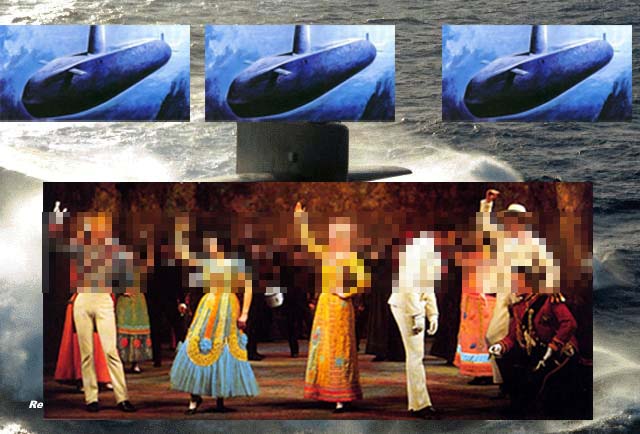
The final scene
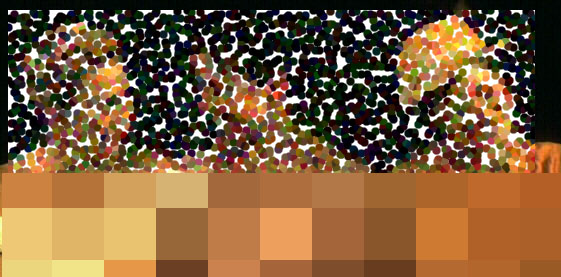
Hero, Beatrice and Gioconda
